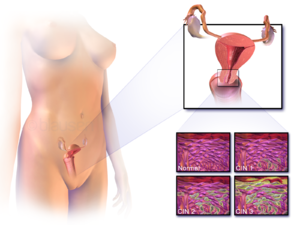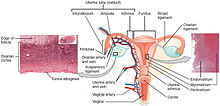ਬੱਚੇਦਾਨੀ ਦਾ ਕੈਂਸਰ
| Cervical cancer | |
|---|---|
 | |
| Location of cervical cancer and an example of normal and abnormal cells | |
| ਵਿਸ਼ਸਤਾ | Oncology |
| ਲੱਛਣ | Early: none Later: vaginal bleeding, pelvic pain, pain during sexual intercourse |
| ਆਮ ਸ਼ੁਰੂਆਤ | Over 10 to 20 years |
| ਕਿਸਮ | Squamous cell carcinoma, adenocarcinoma, others |
| ਕਾਰਨ | Human papillomavirus infection (HPV) |
| ਜ਼ੋਖਮ ਕਾਰਕ | Smoking, weak immune system, birth control pills, starting sex at a young age, many sexual partners or a partner with many sexual partners[1] |
| ਜਾਂਚ ਕਰਨ ਦਾ ਤਰੀਕਾ | Cervical screening followed by a biopsy |
| ਬਚਾਅ | Regular cervical screening, HPV vaccines, condoms |
| ਇਲਾਜ | Surgery, chemotherapy, radiation therapy |
| Prognosis | Five-year survival rate: 68% (US) 46% (India)[2] |
| ਅਵਿਰਤੀ | 570,000 new cases (2018)[3] |
| ਮੌਤਾਂ | 311,000 (2018) |
ਬੱਚੇਦਾਨੀ ਦਾ ਕੈਂਸਰ ਬੱਚੇਦਾਨੀ ਦੇ ਮੂੰਹ ਵਿੱਚੋਂ ਪੈਦਾ ਹੋਣ ਵਾਲਾ ਕੈਂਸਰ ਹੈ। ਇਹ ਕੋਸ਼ਾਣੂਆਂ ਦੇ ਅਸਧਾਰਨ ਵਾਧੇ ਕਾਰਨ ਹੁੰਦਾ ਹੈ ਜਿਹਨਾਂ ਕੋਲ ਸਰੀਰ ਦੇ ਦੂਜੇ ਭਾਗਾਂ 'ਤੇ ਹਮਲਾ ਕਰਨ ਜਾਂ ਫੈਲਣ ਦੀ ਸਮਰੱਥਾ ਹੁੰਦੀ ਹੈ।[4] ਸ਼ੁਰੂਆਤ 'ਚ, ਆਮ ਤੌਰ 'ਤੇ ਕੋਈ ਲੱਛਣ ਨਹੀਂ ਹੁੰਦੇ ਹਨ। ਬਾਅਦ 'ਚ ਇਸ ਦੇ ਲੱਛਣਾਂ ਵਿੱਚ ਜਿਨਸੀ ਸੰਬੰਧਾਂ ਦੌਰਾਨ ਅਸਧਾਰਨ ਯੋਨੀ ਦਾ ਖੂਨ ਨਿਕਲਣਾ, ਪੇਡ ਦਾ ਦਰਦ ਜਾਂ ਦਰਦ ਸ਼ਾਮਲ ਹੋ ਸਕਦੇ ਹਨ।[5] ਭਾਵੇਂ ਕਿ ਸੈਕਸ ਪਿੱਛੋਂ ਖੂਨ ਵਗਣਾ ਗੰਭੀਰ ਨਹੀਂ ਹੁੰਦਾ ਹੈ, ਇਹ ਬੱਚੇਦਾਨੀ ਕੈਂਸਰ ਦੀ ਮੌਜੂਦਗੀ ਵੱਲ ਵੀ ਸੰਕੇਤ ਕਰ ਸਕਦਾ ਹੈ।[6]
ਹਿਊਮਨ ਪੈਪੀਲੋਮਾਵਾਇਰਸ ਇਨਫੈਕਸ਼ਨ (ਐਚ.ਪੀ.ਵੀ.) 90% ਤੋਂ ਵੱਧ ਕੇਸਾਂ ਦਾ ਕਾਰਨ ਬਣਦਾ ਹੈ;[7][8] ਜ਼ਿਆਦਾਤਰ ਲੋਕ ਜਿਹਨਾਂ ਨੂੰ ਐਚ. ਪੀ.ਵੀ. ਦੀ ਲਾਗ ਹੈ, ਪਰ, ਬੱਚੇਦਾਨੀ ਕੈਂਸਰ ਨੂੰ ਵਿਕਸਿਤ ਨਹੀਂ ਕਰਦਾ ਹੈ।[9][10] ਹੋਰ ਜੋਖਮ ਦੇ ਕਾਰਕ ਜਿਵੇਂ ਕਿ ਸਿਗਰਟਨੋਸ਼ੀ, ਇੱਕ ਕਮਜ਼ੋਰ ਇਮਿਊਨ ਸਿਸਟਮ, ਗਰਭ ਨਿਰੋਧਕ ਗੋਲੀਆਂ, ਛੋਟੀ ਉਮਰ ਵਿੱਚ ਸੈਕਸ ਸ਼ੁਰੂ ਕਰਨਾ, ਅਤੇ ਬਹੁਤ ਸਾਰੇ ਜਿਨਸੀ ਸਾਥੀ ਹੋਣਾ ਸ਼ਾਮਿਲ ਹੁੰਦਾ ਹੈ, ਪਰ ਇਹ ਘੱਟ ਮਹੱਤਵਪੂਰਨ ਹਨ।[11][12] ਬੱਚੇਦਾਨੀ ਕੈਂਸਰ ਖਾਸ ਤੌਰ 'ਤੇ 10 ਤੋਂ 20 ਸਾਲਾਂ ਦੇ ਸਮੇਂ ਪੂਰਵਕ ਤਬਦੀਲੀਆਂ ਤੋਂ ਪੈਦਾ ਹੁੰਦੀ ਹੈ। ਬੱਚੇਦਾਨੀ ਕੈਂਸਰ ਦੇ ਤਕਰੀਬਨ 90% ਕੇਸ ਸਕੁਆਮਸ ਸੈਲ ਕਾਰਸਿਮਸ ਹਨ, 10% ਐਡੀਨੋਕੈਰਕਿਨੋਮਾ ਹਨ, ਅਤੇ ਇੱਕ ਛੋਟੀ ਜਿਹੀ ਗਿਣਤੀ ਹੋਰ ਕਿਸਮ ਦੀਆਂ ਹਨ।
ਚਿੰਨ੍ਹ ਅਤੇ ਲੱਛਣ
[ਸੋਧੋ]ਬੱਚੇਦਾਨੀ ਕੈਂਸਰ ਦਾ ਸ਼ੁਰੂਆਤੀ ਪੜਾਅ ਲੱਛਣਾਂ ਤੋਂ ਬਿਲਕੁਲ ਮੁਕਤ ਹੋ ਸਕਦਾ ਹੈ।[13][14] ਯੋਨੀ ਰਾਹੀਂ ਖੂਨ ਨਿਕਲਣਾ, ਕਾਨਟੈਕਟ ਖੂਨ ਵਹਿਣਾ (ਇੱਕ ਸਭ ਤੋਂ ਆਮ ਰੂਪ ਜਿਨਸੀ ਸੰਬੰਧਾਂ ਦੇ ਬਾਅਦ ਖੂਨ ਨਿਕਲਣਾ), ਜਾਂ (ਘੱਟ) ਜੰਮਣ ਕਾਰਨ ਯੋਨੀ ਦਰਦ ਦੀ ਮੌਜੂਦਗੀ ਦਾ ਸੰਕੇਤ ਹੋ ਸਕਦਾ ਹੈ। ਨਾਲ ਹੀ, ਜਿਨਸੀ ਸੰਬੰਧਾਂ ਅਤੇ ਯੋਨੀ ਡਿਸਚਾਰਜ ਦੇ ਦੌਰਾਨ ਮੱਧਮ ਦਰਦ ਬੱਚੇਦਾਨੀ ਕੈਂਸਰ ਦੇ ਲੱਛਣ ਹਨ।[15]
ਕਾਰਨ
[ਸੋਧੋ]

ਕੁਝ ਕਿਸਮ ਦੇ ਐਚ.ਪੀ.ਵੀ. ਨਾਲ ਲਾਗ ਬੱਚੇਦਾਨੀ ਕੈਂਸਰ ਲਈ ਸਭ ਤੋਂ ਵੱਡਾ ਜੋਖਮ ਕਾਰਕ ਹੁੰਦਾ ਹੈ, ਜੋ ਸਿਗਰਟਨੋਸ਼ੀ ਤੋਂ ਬਾਅਦ ਹੁੰਦੀ ਹੈ।[16] ਐਚਆਈਵੀ ਦੀ ਲਾਗ ਵੀ ਇੱਕ ਖ਼ਤਰਨਾਕ ਕਾਰਕ ਹੁੰਦਾ ਹੈ। ਬੱਚੇਦਾਨੀ ਦੇ ਕੈਂਸਰ ਦੇ ਸਾਰੇ ਕਾਰਨਾਂ ਨੂੰ ਜਾਣਿਆ ਨਹੀਂ ਜਾਂਦਾ ਹੈ, ਹਾਲਾਂਕਿ, ਕਈ ਹੋਰ ਯੋਗਦਾਨ ਪਾਉਣ ਵਾਲੇ ਕਾਰਕ ਸ਼ਾਮਲ ਕੀਤੇ ਗਏ ਹਨ।।[17]
ਇਤਿਹਾਸ
[ਸੋਧੋ]- 400 BCE — Hippocrates noted that cervical cancer was incurable
- 1925 — Hinselmann invented the colposcope
- 1928 — Papanicolaou developed the Papanicolaou technique
- 1941 — Papanicolaou and Traut: Pap test screening began
- 1946 — Aylesbury spatula was developed to scrape the cervix, collecting the sample for the Pap test
- 1951 — First successful in-vitro cell line, HeLa, derived from biopsy of cervical cancer of Henrietta Lacks
- 1976 — Harald zur Hausen and Gisam found HPV DNA in cervical cancer and genital warts; Hausen later won the Nobel Prize for his work[18]
- 1988 — Bethesda System for reporting Pap results was developed
- 2006 — First HPV vaccine was approved by the FDA
ਹਵਾਲੇ
[ਸੋਧੋ]- ↑ Bosch, FX; de Sanjosé, S (2007). "The epidemiology of human papillomavirus infection and cervical cancer". Disease Markers. 23 (4): 213–27. doi:10.1155/2007/914823. PMC 3850867. PMID 17627057.
{{cite journal}}: CS1 maint: unflagged free DOI (link) - ↑ "Global Cancer Facts & Figures 3rd Edition" (PDF). 2015. p. 9. Archived from the original (PDF) on 2017-08-22. Retrieved 29 August 2017.
{{cite web}}: Unknown parameter|dead-url=ignored (|url-status=suggested) (help) - ↑ Bray, Freddie; Ferlay, Jacques; Soerjomataram, Isabelle; Siegel, Rebecca L.; Torre, Lindsey A.; Jemal, Ahmedin (2018). "Global cancer statistics 2018: GLOBOCAN estimates of incidence and mortality worldwide for 36 cancers in 185 countries". CA: A Cancer Journal for Clinicians. 68 (6): 394–424. doi:10.3322/caac.21492. ISSN 0007-9235. PMID 30207593.
- ↑ "Defining Cancer". National Cancer Institute. 2007-09-17. Archived from the original on 25 June 2014. Retrieved 10 June 2014.
{{cite web}}: Unknown parameter|dead-url=ignored (|url-status=suggested) (help) - ↑ "Cervical Cancer Treatment (PDQ®)". NCI. 2014-03-14. Archived from the original on 5 July 2014. Retrieved 24 June 2014.
{{cite web}}: Unknown parameter|dead-url=ignored (|url-status=suggested) (help) - ↑ Tarney, CM; Han, J (2014). "Postcoital bleeding: a review on etiology, diagnosis, and management". Obstetrics and Gynecology International. 2014: 1–8. doi:10.1155/2014/192087. PMC 4086375. PMID 25045355.
{{cite journal}}: CS1 maint: unflagged free DOI (link) - ↑ Kumar V, Abbas AK, Fausto N, Mitchell RN (2007). Robbins Basic Pathology (8th ed.). Saunders Elsevier. pp. 718–721. ISBN 978-1-4160-2973-1.
- ↑ Kufe, Donald (2009). Holland-Frei cancer medicine (8th ed.). New York: McGraw-Hill Medical. p. 1299. ISBN 9781607950141. Archived from the original on 2015-12-01.
{{cite book}}: Unknown parameter|dead-url=ignored (|url-status=suggested) (help) - ↑ World Cancer Report 2014. World Health Organization. 2014. pp. Chapter 5.12. ISBN 978-9283204299.
- ↑ Dunne, EF; Park, IU (Dec 2013). "HPV and HPV-associated diseases". Infectious Disease Clinics of North America. 27 (4): 765–78. doi:10.1016/j.idc.2013.09.001. PMID 24275269.
- ↑ "Cervical Cancer Treatment (PDQ®)". NCI. 2014-03-14. Archived from the original on 5 July 2014. Retrieved 24 June 2014.
{{cite web}}: Unknown parameter|dead-url=ignored (|url-status=suggested) (help) - ↑ "Cervical Cancer Treatment (PDQ®)". National Cancer Institute. 2014-03-14. Archived from the original on 5 July 2014. Retrieved 25 June 2014.
{{cite web}}: Unknown parameter|dead-url=ignored (|url-status=suggested) (help) - ↑ Kumar V, Abbas AK, Fausto N, Mitchell RN (2007). Robbins Basic Pathology (8th ed.). Saunders Elsevier. pp. 718–721. ISBN 978-1-4160-2973-1.
- ↑ "Cervical cancer". Am Fam Physician. 61 (5): 1369–76. 2000. PMID 10735343. Archived from the original on 2005-02-06.
{{cite journal}}: Unknown parameter|dead-url=ignored (|url-status=suggested) (help) - ↑ "Cervical Cancer Symptoms, Signs, Causes, Stages & Treatment". medicinenet.com.
- ↑ "Smoking habit, immune suppression, oral contraceptive use, and hormone replacement therapy use and cervical carcinogenesis: A review of the literature". Gynecological Endocrinology. 27 (8): 597–604. 2011. doi:10.3109/09513590.2011.558953. PMID 21438669.
- ↑ "Cervical Cancer Symptoms, Signs, Causes, Stages & Treatment". medicinenet.com.
- ↑ zur Hausen, Harald (2002). "Papillomaviruses and cancer: from basic studies to clinical application". Nature Reviews Cancer. 2 (5): 342–350. doi:10.1038/nrc798. ISSN 1474-1768. PMID 12044010.
ਹੋਰ ਪੜ੍ਹੋ
[ਸੋਧੋ]- Arbyn, M.; Castellsague, X.; de Sanjose, S.; Bruni, L.; Saraiya, M.; Bray, F.; Ferlay, J. (6 April 2011). "Worldwide burden of cervical cancer in 2008". Annals of Oncology. 22 (12): 2675–2686. doi:10.1093/annonc/mdr015. PMID 21471563.
- Chuang, L. T.; Temin, S.; Camacho, R.; Duenas-Gonzalez, A.; Feldman, S.; Gultekin, M.; Gupta, V.; Horton, S.; Jacob, G.; Kidd, E. A.; Lishimpi, K.; Nakisige, C.; Nam, J.-H.; Ngan, H. Y. S.; Small, W.; Thomas, G.; Berek, J. S. (25 May 2016). "Management and Care of Women With Invasive Cervical Cancer: American Society of Clinical Oncology Resource-Stratified Clinical Practice Guideline". Journal of Global Oncology. 2 (5): 311–340. doi:10.1200/JGO.2016.003954. PMC 5493265. PMID 28717717.
- Peto J, Gilham C, Fletcher O, Matthews FE (2004). "The cervical cancer epidemic that screening has prevented in the UK". Lancet. 364 (9430): 249–56. doi:10.1016/S0140-6736(04)16674-9. PMID 15262102.
- Pimenta, Jeanne M; Galindo, Claudia; Jenkins, David; Taylor, Sylvia M (21 November 2013). "Estimate of the global burden of cervical adenocarcinoma and potential impact of prophylactic human papillomavirus vaccination". BMC Cancer. 13 (1): 553. doi:10.1186/1471-2407-13-553. PMC 3871005. PMID 24261839.
{{cite journal}}: CS1 maint: unflagged free DOI (link)
ਬਾਹਰੀ ਲਿੰਕ
[ਸੋਧੋ]| ਵਰਗੀਕਰਣ | |
|---|---|
| ਬਾਹਰੀ ਸਰੋਤ |
